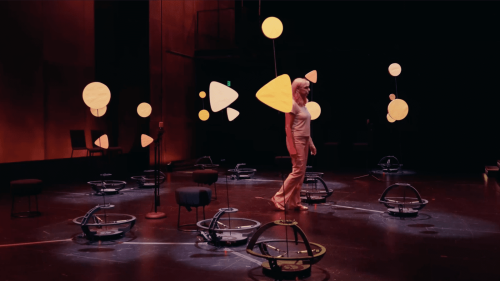
Naomi Ehrich Leonard (pictured) and Susan Marshall merged their expertise to create “Rhythm Bots,” an interactive display exploring collective behavior and rhythmic connection between humans and machines. Video still by Mark DeChiazza
By Alaina O'Regan
April 29, 2025
This article is from the Art + Engineering issue of EQuad News magazine.
Naomi Ehrich Leonard has always been amazed by collective behaviors in nature, whether a flock of birds whirling through the air like a smoke cloud or a flashing, twisting school of fish.
“They move so quickly and effortlessly, and with no choreographer, no central control,” she said.
This emergent coordination inspires Leonard’s work in robotics and mobile sensor networks — exploring feedback and dynamics in collective behavior.
Across campus, dance professor Susan Marshall choreographs performances that examine the roles of control, agency, and interdependence.
Leonard, chair of the Department of Mechanical and Aerospace Engineering, was a dancer herself. She said it was clear that she and Marshall were exploring similar questions.
Although they represent different disciplines, the two have worked together for over a decade. “Our collaboration took off when I met Susan Marshall after she attended a public lecture I gave on the topic of collective motion,” Leonard said.
It started with “Flock Logic,” a performance piece that examines how individuals move in response to one another when guided by simple rules. Next, Leonard joined Marshall, director of Princeton’s Program in Dance, in a study that led to Marshall’s “Rhythm Bath,” an immersive dance performance that explored whether the synchronous movements of dancers could create a meditative space for their audience.
Inspired by these projects, Leonard consulted with Marshall in 2023 to create “Rhythm Bots,” an interactive installation where participants wander among a field of tall, slender robots that respond to their changing environment with gentle, rhythmic rotations.
The custom-made bots, adorned with cutouts of simple shapes and colors, make independent decisions to rotate in response to communicated signals from one another and to visual cues of audience members. Synchronicity arises in the movement of the bots from their designed feedback dynamics. In 2024 Dan Trueman, chair of Princeton’s music department, and Jane Cox, director of theater, joined the collaboration and extended the bots’ movements with sound and light. Leonard said the project provides an inspiring avenue for her investigations into how collective behaviors emerge in a group of individuals.
She said that “Rhythm Bots” also provides a unique lens for studying human-machine interaction.
“These collaborations lead me to ask new questions,” Leonard said. “They create paths for explorations that expand my research.”